Every office floor tells a tale, yet not every tale is clean. How to clean commercial carpets often puzzles managers, since dirt never politely asks entry. The issue grows deeper when carpets trap dust, allergens, and coffee spills. These floors then slowly lose color, luster, and shape. A basic vacuum routine can help, yet grime still hides deeper below fibers.
The fix lies not in ignoring, but in adopting smart carpet plans. A strong cleaning path keeps carpets alive, and firms avoid costly early replacement. This blog outlines proven ways to fight stains, germs, and dull looks. We mix data, wit, and expert voice, showing managers practical steps.
From hot water extraction to quirky bonnet cleaning methods, each idea fits business needs. Our promise is clear: you will learn safe tricks that last. By the end, you will hold commercial carpet maintenance tips for lasting pride.
Why Commercial Carpet Cleaning Matters
Firms often overlook the basics of how to clean commercial carpets, causing health risks. Hygiene stays vital when staff walk floors daily, dragging dirt and crumbs inside. Clean carpets trap fewer allergens, mold spores, or mites. Workplaces remain healthier, and fewer coughs spread across office rooms. Regular care builds trust, creating floors that breathe freshness daily and lift moods. Business owners know a spotless floor shows order, not neglect or mess. This practice means work stays efficient, and less sick leave hurts profit margins.
A hidden truth is that costs grow huge when cleaning routines are ignored. New carpet buys can drain budgets, forcing firms into needless large spends. Yet with steady care, fibers survive years without premature dullness or tear. Maintenance proves cheaper, easier, and safer than yearly new rolls. Smart leaders see value in cleaning cycles, since savings add up over time. Skipping upkeep means bigger bills, and poor looks harm overall client trust.
Residential rugs differ from sturdy rolls laid in lobbies or malls. Commercial fibers face shoes, carts, and spills daily. Stronger yet prone to deep grit, they demand specialized care methods. Cleaning challenges differ: residential spaces allow mild agents, while offices need industrial blends. Firms must tailor plans, matching fabric durability with safe yet deep processes. Workplace carpets face harsh wear, so methods must extend life, not shorten it.
Impact on Brand Image
A clean carpet is never silent. It shouts trust toward all who enter. Guests, clients, or random visitors quickly form views based on spotless flooring sights. First looks matter, and stains suggest laziness. Good upkeep adds polish, charm, and respect. Brand image thrives when neat carpets echo high standards, not sloppy cutbacks.
Hotels, retail stores, and offices live daily under sharp customer eyes. Clean floors boost confidence, while dirty marks raise questions about management skills. Good upkeep creates visual pride, where staff feel proud of their surroundings. Public trust grows with visual cues, and carpets remain subtle messengers. Thus, brand strength ties not only to ads, but also to flooring health.
Health & Indoor Air Quality
Dust, pollen, and hair never knock before they step on carpets. Once trapped, these particles lurk and stir whenever feet cross again. Stain removal commercial carpets processes clear hidden invaders, keeping lungs safe from asthma or allergies. Carpets can act as filters, but too full, they harm more than help. Staff wellbeing improves when fibers stay groomed, and productivity rises alongside health.
Dirty carpets act like silent sinks, storing pollutants over long hidden months. Bacteria, spores, or mites hide within layers. Ignoring cleaning cycles harms both staff and client trust. A sound plan keeps the air clean, not stale or toxic. High-end commercial carpet care includes frequent sanitizing, ensuring no buildup of harmful particles. Safe offices attract clients and talent, since health remains a visible business value. Managers cannot ignore flooring, since clean fibers equal safe breathing inside.
Commercial Carpet Cleaning Methods Explained
Commercial carpet cleaning offers multiple paths, each shaped by fabric type, stain depth, and time. Offices must weigh the pros and cons before choosing, since every method has unique strengths. Here, we cover the main techniques in detail, offering insight that beats vague guides.
Hot Water Extraction (Steam Cleaning)
How It Works
Pre-spray loosens grit, agitation spreads the solution, and suction extracts dirty water fast. This method ensures deep fiber cleansing, reaching where vacuum or surface wipes never succeed. Carpets dry more slowly, yet the cleanliness achieved feels unmatched, leaving staff impressed and safe.
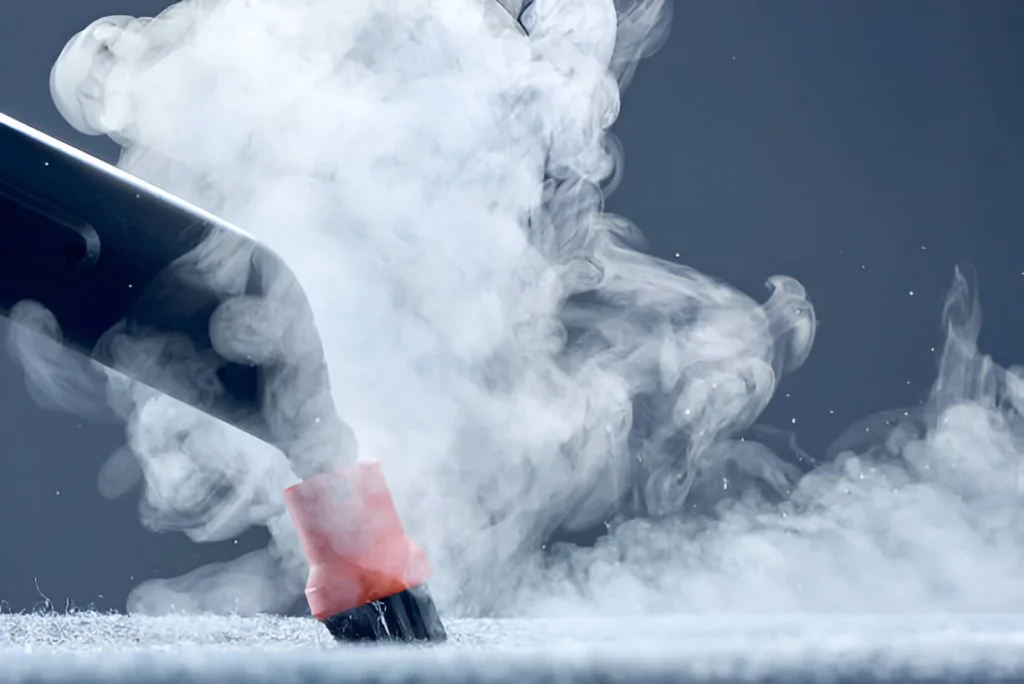
Pros
Hot water extraction reaches deep, killing bacteria that lurk hidden within layers. Allergens reduce, health improves, and workplace comfort grows steady. Appearance refreshes too, since dull colors revive bright hues. Clients value this method for thoroughness, not speed.
Cons
Drying takes longer, delaying room use. Damp floors may concern managers during peak hours. Equipment costs more, and trained staff must operate machines carefully. Despite these drawbacks, the results make this method highly valued among pros.
Best Use
Ideal for scheduled deep cleaning in hotels or clinics where hygiene ranks high. Suited for quarterly cycles, not daily touch-ups. Managers invest time wisely, ensuring fibers remain strong. This method builds carpet life, not shortens it, keeping budgets steady.
Dry Carpet Cleaning (Low-Moisture)
Quick Needs
Offices or shops often need clean floors ready within hours. Dry carpet cleaning uses compound powder spread across fibers. Grit sticks, then the vacuum removes residue. Floors return ready fast, ideal for high-traffic areas needing short downtime.
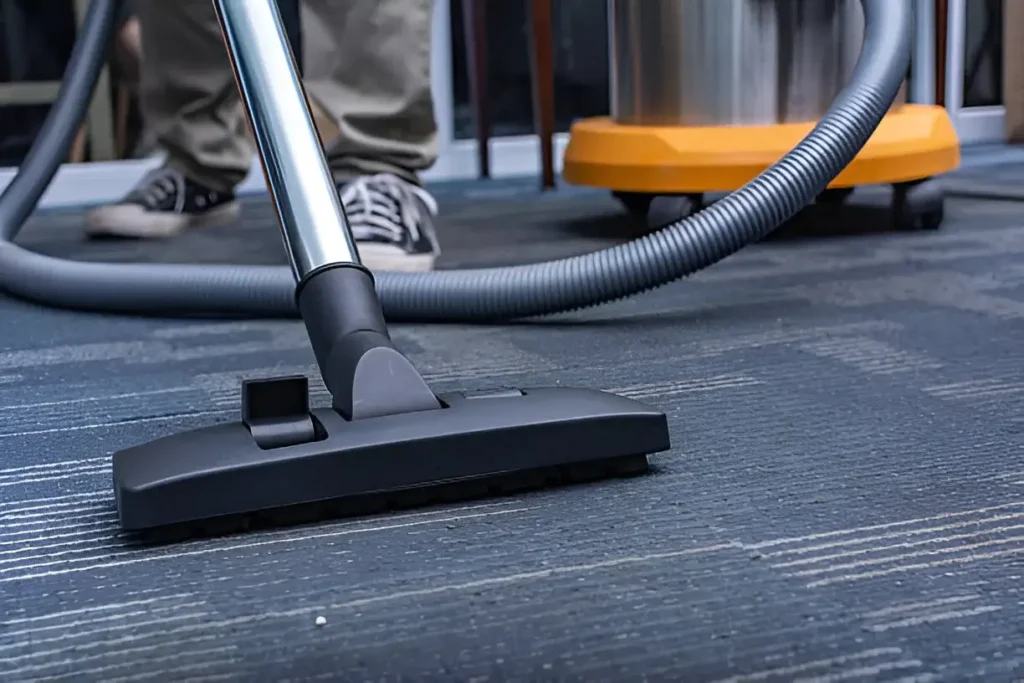
Process Detail
Compound absorbs dirt, breaking grime without excess water. Machines spread and brush powder thoroughly. Over time, the vacuum clears it away. Staff appreciate simplicity, and work continues smoothly without risk of damp shoes or mold.
Benefits
Quick turnaround boosts productivity, since spaces reopen swiftly. Moisture stays minimal, so mold risk lowers. This method suits malls or offices, where footfall never stops. Paired with steady schedules, it ensures carpets stay vibrant longer, without major disruption.
Encapsulation Cleaning
Eco Benefit
Encapsulation cleaning uses polymers that trap soil into crystals. Once dry, vacuum lifts debris easily. Encapsulation is modern and green, needing less water and mild agents. Firms like the eco-friendly option, while carpets stay neat between deep cleans.
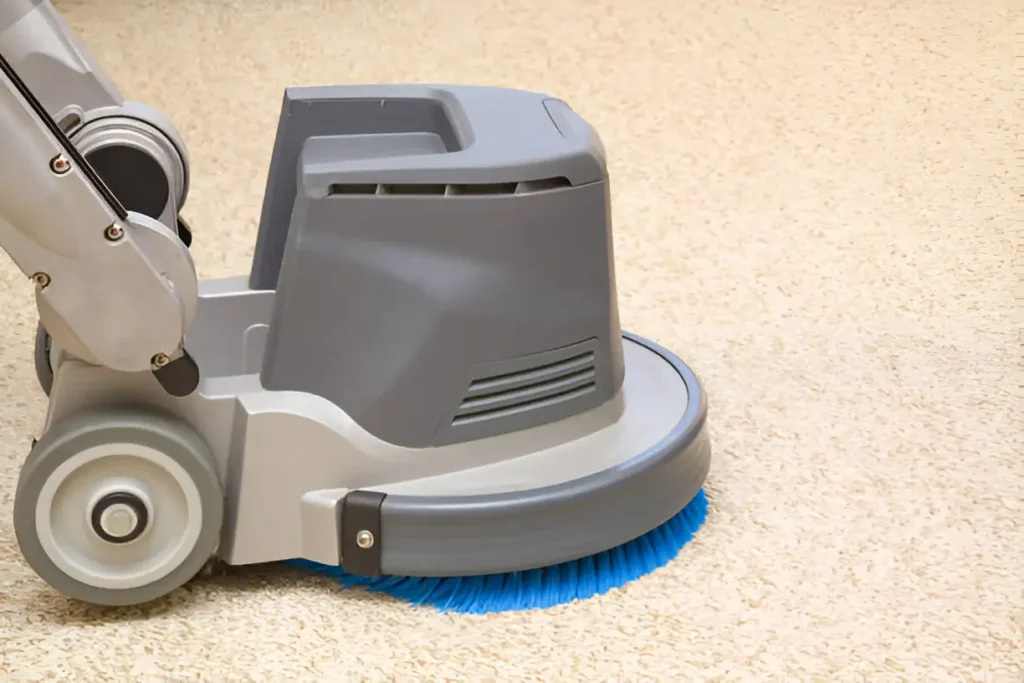
Process Detail
Low-moisture carpet cleaning foam spreads across the carpet, then polymers form shells around dirt. Once brittle, shells break under vacuum. This reduces sticky residue, unlike old shampoo methods. Fibers feel fresh, and colors stay crisp for weeks.
Best Use
Excellent for interim upkeep, not replacing full deep methods. Hotels, airports, and offices adopt it weekly, extending the time between steam cycles. Savings grow, as downtime shrinks. Encapsulation keeps fibers strong, reducing wear. Managers like a balance between green care and cost savings.
Bonnet Cleaning (Surface Method)
Bonnet machines press pads dipped in solution over the surface. A bonnet cleaning method clears surface stains fast, giving floors a neat look. Useful before events, yet dirt below remains.
Suited for short-term polish in halls or conference rooms. Quick and cheap, but not for hygiene-focused sites. Used sparingly, it adds shine when looks outweigh long-term health. A fast fix, not a cure.
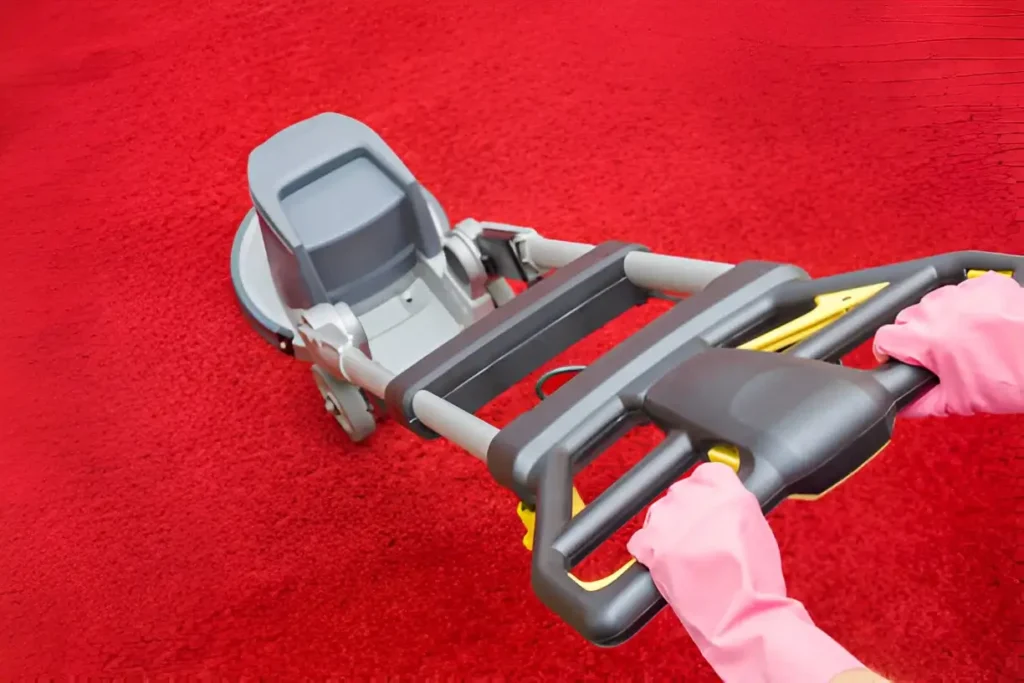
Shampoo Cleaning (Old-School)
Soapy solution spreads across fibers, creating foam. Machines scrub, then vacuum removes residue. Still used in spots, yet not ideal long-term.
Soap leaves sticky film, trapping dirt later. Over-wet carpets risk mold. Thus, though common decades ago, it now loses favor. Modern options like encapsulation or hot water extraction prove safer. Shampoo still lingers where budgets stay thin, though results often disappoint.
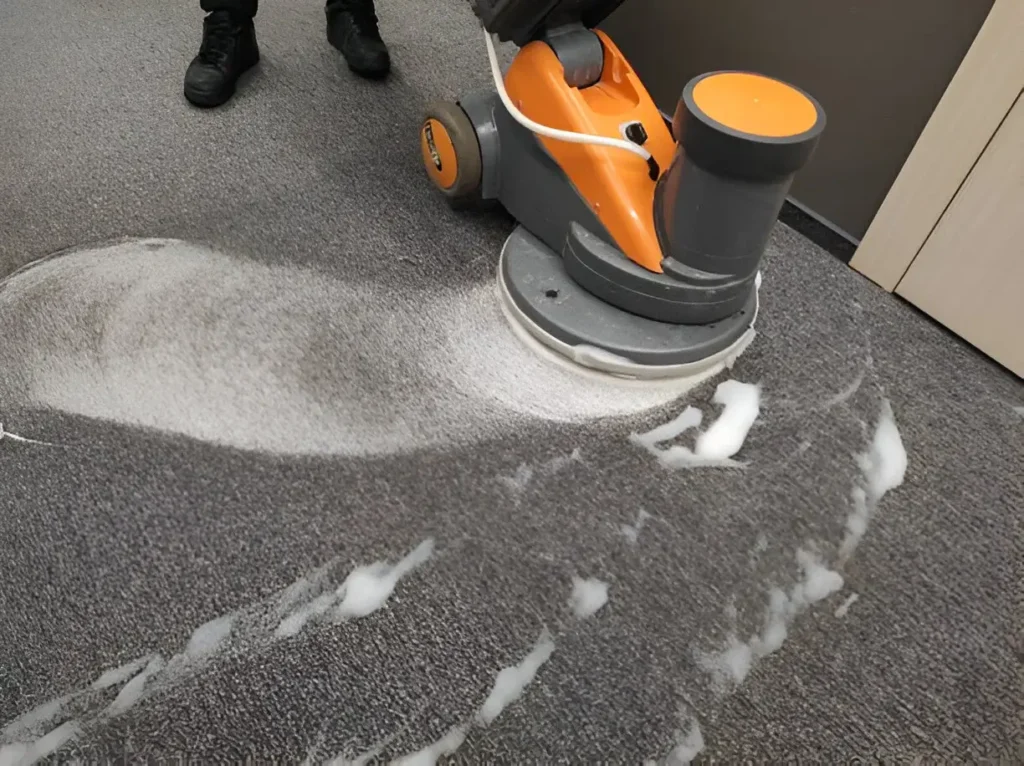
Preparing Carpets Before Cleaning
Furniture never cleans itself, so moving chairs and desks comes first. Shifting items allows access to hidden floor zones, ensuring cleaning covers every inch. Staff should lift carefully, avoiding scratches. Once cleared, vacuums reach corners usually ignored. This setup saves time later, since machines glide without hindrance. Work feels smoother when no chair blocks the scrub path.
Before heavy machines roll, pre-spot steps must happen. Vacuums collect loose grit, easing chemical tasks ahead. Next, stains need mild solutions tested in tiny, hidden areas. Avoid harsh sprays at first, since colors may bleed. This careful start prevents disasters, saving carpets from patchy looks. Firms that skip this step regret the faded marks left in hallways.
Fibers differ, so not all tolerate strong blends. Wool or silk blends suffer damage if the wrong sprays hit hard. Pre-testing ensures safe agents meet delicate fibers gently. This step protects investments, ensuring luxury carpets last. Managers who skip risk costly replacements. Preparation thus proves as vital as cleaning itself, creating peace of mind. Safe carpets mean safe pride for staff and clients alike.
The same mindful approach applies when staff learn how to clean a bathroom. Careful planning with product tests first makes tasks safe, steady, and neat. Attention to hidden spots ensures spaces remain spotless and trusted in any building. Preparation shapes results for firms seeking to clean commercial carpets with full success.
Spot Cleaning & Stain Removal Techniques
Spot removal is a crucial part of how to clean commercial carpets.
Food & Drink Spills
Spills from coffee or soda spread quick, soaking fibers fast. Blotting with a cloth first absorbs liquid before it sets. Neutral cleaners then treat stains without harming fibers. Stain removal in commercial carpets relies on speed, since delays worsen outcomes. Firms should train staff, so first aid for strains happens quick. Prompt care saves carpets from lasting shame.
Grease & Oil Stains
Grease hides deep, clinging to fibers stubbornly. Solvent-based solutions help dissolve oily films, breaking them apart. Staff apply gently, blotting, not rubbing. Scrubbing spreads the stain further, worsening damage. Offices with cafeterias face this issue often. Using safe solvents protects fabric, and repeated care stops buildup.
Ink, Paint & Gum
Creative messes like ink drops or sticky gum require special removers. Ice cubes harden gum, making scraping easier without fiber harm. Ink needs alcohol-based cleaners, dabbed lightly. Paint may need stronger blends, tested in hidden spots first. These steps require patience, since rushing causes permanent harm. Skilled staff make a difference here.
Water Damage & Mold Prevention
Leaks soak carpets fast, breeding mold if ignored. Fans, dehumidifiers, and quick lifts stop growth. Special sprays kill spores before they spread. High-end commercial carpet care insists on prevention, not cure. Firms must inspect roofs or pipes often. Mold left unchecked harms health and ruins fibers.
Best Practices for Long-Term Carpet Maintenance
Daily
Daily upkeep means more than glances at surface shine. Vacuums must run steady, sucking grit before it sinks. Commercial carpet maintenance tips start with small steps done daily, not yearly grand sweeps. Staff should spot stains instantly, dabbing before marks dig deep. Routine saves costs later, since prevention beats cure. This discipline builds pride, since staff see results quick. Offices sparkle daily, drawing nods from clients and joy from staff.
Weekly
Weekly schedules focus on a deeper refresh. Low-moisture carpet cleaning or encapsulation cycles revive fibers. Foam crystals trap dirt, then vacuums lift waste neatly. This keeps fibers crisp between steam cycles. Staff find floors lively, not dull or sticky. Weekly cycles give peace of mind, since dirt never builds up. Managers gain control, since order is visible underfoot. This rhythm ensures carpets survive wear, balancing effort with outcome.
Quarterly
Each quarter demands heavier cycles. Quarterly deep cycles perfect the art of how to clean commercial carpets. Hot water extraction enters here, delivering deep fiber care. Steam digs deep, erasing stains vacuum never touched. Clients sense freshness, staff enjoy brighter halls. Quarterly cycles suit firms aiming for strong standards. Cleanliness adds weight to brand voice, proving promises visible, not empty. This step ensures bacteria never thrive for long. Managers note fewer complaints, and health improves overall.
Annual
Year-end calls for audits and thorough reviews. Inspect seams, fibers, and colors. Deep clean entire zones, not just lobby fronts. Annual sessions rebuild pride, proving care is consistent, not random. Records of upkeep support warranty claims, avoiding disputes with carpet makers. Managers proud of upkeep win trust from staff and clients alike. Annual rhythm completes the cycle, blending daily steps with long goals. Clean floors tell stories, and none involve neglect or shame.
High-Traffic Zone Protection
Entry mats stand guard, catching mud before it spreads. Rotation schedules add defense, ensuring zones wear evenly. Staff must focus on busy paths, not just empty corners. Commercial carpet maintenance tips stress attention to traffic, since it defines lifespan. Small adjustments extend life, preventing early dullness. A lobby mat may look plain, yet it saves thousands yearly. Smart managers rotate carpets across zones, balancing wear. Guests never guess strategy, yet see spotless floors. These details matter, shaping trust and loyalty.
Extending Carpet Lifespan
Protecting fibers requires tools and sprays. Guards shield against stains, and vacuums chosen wisely extend life. Use machines with strong suction but gentle bristles. Harsh tools damage, while correct ones nurture fibers. High-end commercial carpet care means investing in the right gear, not cutting corners. Sprays coat fibers, creating shields against spills. Managers gain calm, knowing accidents stay minor. Staff must train, since misuse ruins carpets. With knowledge, pride grows. This care proves foresight, ensuring carpets last far beyond norms. Budgets stretch, and clients smile. Carpets treated well become silent ambassadors, proving a company’s discipline and values daily.
Mistakes to Avoid in Commercial Carpet Cleaning
Over-Wetting Carpets
Soaking carpets with excess water creates risks of mold, odor, and fiber breakdown. Without strong airflow, dampness lingers, causing hidden health threats. Mold spores thrive, and repairs cost dearly. Smart cleaners control water carefully, balancing deep clean with safe drying. Managers must insist on skilled staff, since errors here damage both health and budgets.
Using Harsh Chemicals
Strong blends strip fibers, fading colors, and weakening structure. Harsh sprays promise speed, but results disappoint long term. Sensitive fabrics, like wool or silk, suffer most. Safer green solutions protect fibers while still fighting stains. Staff must test agents before use, avoiding surprises. High-end commercial carpet care rejects shortcuts, investing in methods that respect material integrity above all.
Neglecting Airflow
After cleaning, airflow matters as much as washing itself. Ignored fans or closed windows prolong drying, inviting odors and microbes. Circulation removes moisture fast, saving carpets from lasting damage. Managers must prioritize ventilation, ensuring dehumidifiers and fans operate correctly. Neglect here undermines even perfect washing steps, showing that small oversight creates major costs later.
Ignoring Warranty Guidelines
Carpet makers supply care rules, yet many managers skip them. Warranty coverage vanishes if terms are ignored. Using the wrong agents or failing scheduled cleans voids claims instantly. Careful record keeping proves compliance, safeguarding rights. Firms must respect warranties to avoid costly disputes. Professional services often guide managers here, blending expertise with compliance assurance.
Eco-Friendly & Sustainable Carpet Cleaning Options
Plant-Based Detergents
Green blends made from plants are clean without harsh residue. These solutions break grime gently, sparing fibers from chemical stress. Businesses choosing eco cleaners reduce toxins, protecting both staff and clients. High-end commercial carpet care often highlights sustainability, since image ties with responsibility. Using plant agents shows commitment, not shortcuts. Firms enjoy safe air, clean carpets, and a greener brand voice that attracts trust.
Water-Saving Encapsulation
Encapsulation cleaning saves water by using foam with polymers. These polymers trap dirt, forming crystals removed later by vacuum. Less liquid means quicker drying, fewer risks, and eco merit. Firms cut costs by reducing water use, while still gaining neat results. Clients admire responsibility, since waste reduction aligns with modern green values. This method bridges efficiency and care, proving that sustainability supports business, not hinders it.
Certifications & Standards
Carpets cleaned with certified eco methods earn seals of approval. CRI and Green Seal labels assure compliance with safety and quality. Managers display these proudly, proving standards met. Certifications guide clients seeking responsible partners. Such marks build reputation, showing dedication beyond profit. Eco standards boost market edge, separating careless firms from forward thinkers. Certification thus blends pride, trust, and recognition.
Now you understand how to clean commercial carpets like a pro. For more details and our commercial carpet cleaning services contact us CCS Complete Clean Solutions.
FAQs
Frequency depends on traffic, yet most firms benefit from quarterly deep cycles. Busy zones like lobbies may need monthly care. Lighter zones, such as conference rooms, can stretch intervals. Following the schedules ensures fibers stay strong, avoiding sudden dull looks. Ignoring timing means costly replacements sooner than planned.
Hot water extraction works wonders, yet not all fibers welcome it. Delicate blends like silk or wool risk harm. Testing small areas prevents mishaps. Professionals adjust temperature and pressure, tailoring methods to material needs. Safety lies in precision, not one-size solutions. Managers must confirm fiber type before choosing steam.
Dry carpet cleaning shines when time is short. Powders absorb dirt, then vacuums lift residue. Floors return ready within hours, avoiding downtime. Offices resume work without soggy shoes. Managers like speed, while staff admire fresh looks. Quick cycles still deliver reliable surface results.
Encapsulation cleaning and plant-based agents prove green can equal clean. Modern formulas trap dirt effectively, leaving fibers crisp. Clients see no loss, only gain in safety. Green options protect staff lungs, while branding improves. Firms choosing eco paths blend responsibility with practicality, pleasing both budget and conscience.
Coffee stains demand speed. Blot first, apply neutral cleaner next. Repeat dabbing gently. For tough spots, specialized solutions handle deeper marks. Stain removal commercial carpet methods teach patience, not force. With prompt steps, stains vanish without fiber harm. Staff training ensures mistakes never worsen issues.
High-end commercial carpet care blends multiple methods across time. Steam deep cleans, encapsulation maintains, and spot care fixes accidents. Balanced schedules give carpets longevity beyond expectations. No single method rules alone. Harmony ensures fibers endure pressure, spills, and traffic for years.
In-house staff manage daily upkeep, yet pros deliver deeper expertise. Machines, agents, and training matter. Outsourcing ensures compliance with warranty and safety rules. Costs may rise, yet long-term value justifies the spend. Managers balance needs, blending internal care with scheduled pro visits. Wise leaders choose both, not one.

